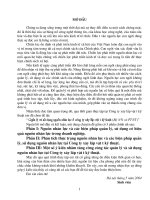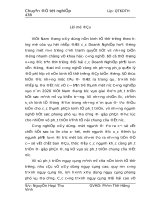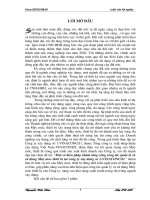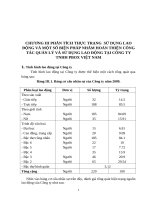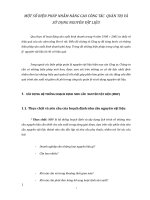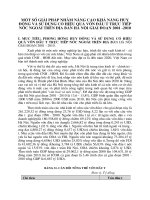Một số kinh nghiệm nhằm giúp học sinh lớp 7 học và sử dụng từ vựng đạt hiệu quả
Bạn đang xem bản rút gọn của tài liệu. Xem và tải ngay bản đầy đủ của tài liệu tại đây (1.37 MB, 25 trang )
1. INTRODUCTION
1.1. Reasons for choosing the research
English is an international language which has developed quickly. It is a
subject that features regularly on study timetables all over the world. Every country
does not want to be isolated in international communication, so it puts English in
curriculum of their education at programme. In Vietnam, English is a compulsory
subject at schools and it has recently been chosen as a compulsory subject in the
national examination for the General Certificate of Secondary Education or GCSE
for short. Besides the four skills, having a good knowledge of vocabulary is an
important element in second language acquisition. By learning new words, learners
can enhance their listening, speaking, reading and writing as well as improve
comprehension and production in second language. Vocabulary learning strategies
are one part of language learning strategies which in turn are part of general
learning strategies. One of the strategies to teach vocabulary is to apply images and
review well in a structured way. Using mind maps is considered to be one of the
techniques or activities which can be used in eliciting students how to study and
use vocabulary more effectively.
For all the reasons mentioned above, I have decided to choose " Some
experiences in eliciting students of grade 7 study and use vocabulary
effectively by using mind maps " (New English Textbook) " as the topic of my
experience initiative.
1.2. Aim
The study is aimed at finding the ways in eliciting students to study and use
vocabulary by using mind maps for students of grade 7 at ......... secondary school
effectively with the textbook English 7.
1.3. Researching object
Some experiences in eliciting students of grade 7 study and use vocabulary
effectively by using mind maps " (New English Textbook) "
1.4. Researching methods
The writer did some steps to do this research, they are as follows;
1.4.1. Researching method to construct the theoretical basic.
1.4.2.Surveying method the reality relating to do the problem.
1.4.3. Method of collecting the data through the test and posttest;
1.4.4 . Method of analyzing the data;
1.5. New points of my experience initiative:
The research will be useful to students, teachers and researchers in the field of
English language teaching and learning: students can use mind mapping (MM)
model to study and use vocabulary more quickly and more effectively; teachers can
understand more about the MM model and use it to teach vocabulary more
1
effectively in their lessons; and researchers will use the study as a reliable source
of reference in their research.
2. CONTENT
2.1. Theoretical background:
2.1.1. An overview of vocabulary.
Vocabulary is a list of words in a language with their meaning (Hornby,
2000:1331). Saleh (1997:60) states that vocabulary items fall into two principle
categories, they are; (1) concrete words and (2) abstract words.
2.1.1.1. Concrete Words
Saleh (1997:60) states that a concrete word is a word that the meaning can
be perceived through one or more of the five senses. The meaning of concrete
word can be pointed out by means of Audio Visual Aids (AVA), like realia (real
things), miniatures, pictures, and demonstration.
2.1.1.2. Abstract Words
Saleh (1990:60) states that an abstract word is a word that the meaning of
which cannot generally be grasped by virtue of the five senses. The notion of
abstract word are like "thank" and "enjoy", its can be shown by circumlocution or
translation.
2.1.1.3. Strategies of eliciting students how to study and use vocabulary.
* Stages and techniques in eliciting students how to study and use vocabulary
a. Presenting
At this stage, the teacher presents the new words and the techniques are often used
such as translation, real things, pictures, actions /gestures, definitions, situations/
examples.
b.Practicing
At this stage, the students are made to practice the new words. The techniques are
often used such as identifying, selecting, matching, sorting, ranking and
sequencing.
c.Consolidating and revising
At this stage, the techniques are often used such as ordering, rub out and
remember, networks, bingo, wordstorm, slap the board, matching, noughts and
crosses, what and where, jumbed words, guess the pictures
2.1.1.4. Vocabulary in English textbook grade 7.
The vocabulary in English 7 is continued to present and build up according
to topics. That is why using mind maps is believed to be a good way to help
students not only review the learned words but also learn the new ones.
2.1.2. An overview of mind maps.
2.1.2.1. Definition
2
Buzan states that a mind map is a powerful graphic technique which
provides a universal key to unlock the potential of the brain. It is a visual map of
ideas, laid out in a radial format around a central thought and it involves a unique
combination of imagery, colour and visual-spatial arrangement which is proven to
significantly improve recall when compared to conventional methods of notetaking and learning by rote. It needs imagination and association to activate our
brain in remembering something.
Based on DePotter and Hernacki as translated into English (in Abdurrahman,
2008:153), “Mind mapping is the use of whole brains technique by using the
visualization and other graphic infrastructure to make an impression”. Besides,
mind mapping is one of techniques which can make the students more enjoyable
and interesting in studying vocabulary.
According to Martin as translated into English (in Trianto, 2009:158) mind
mapping is a concrete graphic illustration which indicates how a single concept
related to other concept in the same categories. Mind mapping is a pattern which at
least consists of picture, symbol and colour that will not just help the students to
understand the vocabulary knowledge but also make the students feel good,
enjoyable and attract their brain which at last leads them to have interest in mastery
vocabulary knowledge.
2.1.2.2. Classifications
Trianto (2009:160) describes that mind mapping can be distinguished into
four kinds, namely; (1) network tree, (2) event chain, (3) cycle concept map, and
(4) spider concept map.
2.1.2.2.1. Event Chain
The event chain can be used for giving an accident order, steps in a
procedure, or steps in a process. It is suitable for visualization (a) some steps in a
process, (b) some steps in a linier procedure, and (c) an accident order.
Ecosystem component
Ecosystem component
Ecosystem component
Ecosystem component
2.1.2.2.2. Network Tree
The main ideas made in a quadrangle and other words written in the
connection line. It is suitable for visualization (a) a cause and effect relation (b) a
3
hierarchy, (c) branch procedure, and (d) technical terms which can be used to
explain some correlations.
2.1.2.2.3. Cycle Concept Map
In this concept map, the accident combination has no final result. It is
suitable to show a correlation how a combination accident is interacting to produce
a group of result repeatedly.
2.1.2.2.4.Spider Concept Map
The spider concept can be used for sharing opinion from a central idea until
get more various big ideas. It is suitable to visualize (a) something which is not
based on hierarchy (b) a category which is not parallel, and (d) the result of sharing
opinion.
4
Example: Unit 1: My hobbies
Mind mapping is similar to a road makes study, work and thinking
enjoyable, it can help to solve the lack of stock of students’ vocabulary in
memorizing some words which are related from universal word as a key word.
2.1.3. How to make a mind map.
2.1.3.1. Parts of Mind Mapping Technique
There are some parts of mind mapping (Windura, 2008:77-86) namely; (1)
central image, (2) key word, (3) basic ordering ideas, (4) branches, (4) colour and
(5) picture.
2.1.3.1.1. Central Image
A central image has to describe the main idea of a mind mapping and put it
on the centre of the paper. It activates the students’ right brain, strengthen the
students’ memory and makes the learning activity enjoyable.
2.1.3.1.2. Key Word
A key word is a word that can lead a sentence or an event. Identifying a
familiar word in one’s own language or another language that sounds like the new
word and using only one key word per line. It is as an urge to remember a lot of
words for the students. It is a strong noun or verb that creates an image to recall the
memory.
2.1.3.1.3. Basic Ordering Ideas
Basic ordering ideas are the branches that collect sort information and it is
connected to the central topic that radiate out from the centre. Making basic
ordering ideas which can direct our mind to make a mind map and it needs the
creativity that encourages the students to understand to the material. It is thick and
5
thinner at the ends. It can be seen as headings for your topic and spread anywhere
but do not become steep.
2.1.3.1.4. Branches
The branches should be curvy and in the same length as the words or
pictures above it. These branches can be seen as sub headings. It is thinner
branches and containing details.
2.1.3.1.5. Colour
Colour is a very good memory sign and it involves the right brain in learning
for long term memory. Colours encourage creativity and help in memorization.
Adding plenty of colours via branches, map background and images will add life to
your mind map. It makes easier to comprehend and remember.
2.1.3.1.6. Pictures
In mind mapping, pictures which can change or strengthen a key word that
has been written before.
* The Criteria of Making Mind Mapping Technique
Based on what Buzan (in Purwoko, 2005:20) states that the mind mapping
uses colors and pictures to help constructing your imagination with your style in
making mind maps. Words or pictures which are in the curvy lines or branches will
help the students’ memory to make associations.
Moreover, Buzan (in Purwoko, 2005:20) explains the steps below in how to
make a mind map, they are presented below;
Step 1. Take a piece of white paper and it is in a landscape position.
Step 2. Start by drawing a coloured image in the centre of the paper and write the
key word with capital letters.
Step 3. Choose a color and draw the main themes of the mind map on the thick
branches radiating out from the central image.
Step 4. Add other main themes branches around the map.
Step 5. Make thick and colourful branches spanning out from your mind map.
Step 6. Write basic ideas about the key word and still use the capital letters.
Step 7. Add an image to all the main branches to represent each key theme and
also use images to visualise every important key word on your map.
Step 8. Let your mind map be as imaginative as possible.
2.1.4. The applications of mind maps in eliciting students how to study and use
vocabulary effectively
2.1.4.1. Using mind maps in eliciting students how to study and use vocabulary
One of the simplest ways how to use a mind map is gathering and sorting new
vocabulary. The example shows sources of energy vocabulary organized in 2
groups. Students find it much easier to memorize the words which they are placed
in a certain spot, connected to a certain topic.
6
Example: Unit 10: Sources of energy
2.1.4.2. Using mind maps to elicit students how to take notes and plan tasks.
Another way of using a mind map is giving students a task where they have
to display a summary of some topics, for example, My favourite food and drink.
Each bubble may contain more than one word or even a phrase. This mind map can
be used by the students in the classroom for making a short speech or a comment
about his favourite food and drink. If a mind map is created by the teacher and
shown at the lesson, it can be used as a basic for classroom discussion or a writing
task.
Older students may use a mind map for outlining their report or an essay.
Example: Unit 5: Vietnamese food and drink
2.2. Problematic situation of studying and using English vocabulary at my
school.
2.2.1. Advantages
My school is one of the best schools in Tho Xuan district with a lot of outstanding
achievements. Teaching and learning English are more and more attached here.
7
2.2.1.1. About the teachers of English.
At my school, there are two English teachers aged from 34 to 36. Both of us were
trained at Hong Duc university. Everyone has been teaching English for over 10
years. We are all young, enthusiastic, active, creative and willing to devote to
teaching career. Both of us can apply new teaching method, the information
technology, teaching aids to teaching skillfully. We are also familiar with the
techniques of teaching and eliciting vocabulary.
2.2.1.2. About the students.
All of the students have learnt English for 3 years at primary schools. Most of them
are obedient and dutiful. They also know how important the English is and they are
also familiar with the different ways of studying and using vocabulary.
2.2.2. Disadvantages.
Besides the advantages above, eliciting for students how to study and use English
vocabulary also have some difficulties.
2.2.2.1. About the teachers.
Some teachers still face a number of difficulties in the implementation of certain
operations, teaching techniques of each lesson, each stage of the lesson or the
combination of the teaching techniques.
Some teachers are still afraid of using or even do not use teaching aids proficiently
for the lesson (For example: laptop, projector, cassette, CD,...).
In eliciting vocabulary, some teachers do not use the different techniques. They
often list the new words on the board then explain them and do not revise the
words at all, which is not easy for students to learn the words eagerly, quickly, and
permanently.
2.2.2.2. About the students.
Although all of the students have learnt English for 3 years at primary schools,
they are different from levels. A number of them are only good at grammar, not at
speaking, reading, writing and listening. Moreover, their vocabulary is very poor.
That is why they do not have enough vocabulary to express their ideas in writing
and speaking and they do not understand what they hear. Consequently, the way to
present the vocabulary is very important to make sure that they remember the
pronunciation, understand the meanings, usages of the new words, the connected
words for a long time.
2.2.2.3. Specific survey.
In the process of teaching, I have been given the duty to teach grade 7. With
the awareness of researching and studying the situation of students’ learning the
subject and learning from experience, right since the beginning of the school year,
I outlined a specific plan and method to actively investigate the situation of
students’ learning in my classes. Though the investigation in four skills, I realized
that most students are neither recognized nor sure about the vocabulary they had
8
listened in listening skill. Hardly did they use the right vocabulary to express their
ideas in speaking and writing skills. In reading skill, they had difficult
understanding the text because of a number of new words. Before applying the
experience initiative in eliciting students of grade 7 to study and use vocabulary for
Unit 1: Hobbies, I asked SS to write hobbies of Unit 1 and make up sentences with
them in 10 minutes . The survey result as follows:
Class
Total
hobbies
hobbies
hobbies
hobbies & hobbies &
number
&
&
&
sentences sentences
of
sentences sentences
sentences
5-->6
3-->4
students
9-->10
7-->8
<3
o
o
o
o
o
N
% N
%
N
%
N
%
N
%
7A
34
3
8.8 10 29.4
15 44.1
5
14.7
1
2.9
7B
34
5 14.7 10 29.4
12 35.3
6
17.6
1
2.9
Total
68
8 11.8 20 29.4
27 39.7 11 16.2
2
2.9
2.3.Some solutions to solve this problem.
2.3.1. Gathering new vocabulary.
Teachers can use the technique to teach verbs, the different forms of verbs, the
different parts of speech of words, the different meanings of words, words related
to a subject, collocation words (words that are commonly used together) and so on.
By using the technique, students will revise the words they have learnt and learn
the new ones from their teacher as well as their friends. They will also have their
own maps of different tasks at home.
Example: Unit 11: Travelling in the future
1.1.1. The steps of eliciting.
9
2.2.3.1.The steps of eliciting:
Step 1: Make a central image/topic in the centre of the paper. Colour and add
something interesting.
Step 2: Draw some basic ordering ideas, spread out from the central image/topic.
Step 3: Thinking of all something interesting as much as possible and funny for
you and it can be connected with the central image to give you the
inspiration.
Step 4: Add some branches to the basic ordering ideas using symbols, pictures, and
colours as much as possible.
Step 5: Thinking of the details which are interesting and it can encourage your
curiousity. Add to your mind map.
Step 6 : Continue it until you have adequate information for your mind map.
2.2.3.2. Example Unit 8: film
2.3.2. Sorting new vocabulary.
Teachers can use the technique to teach synonyms, antonyms and so on.
2.3.2.1. The steps of eliciting.
Step 1: Make a central image/topic in the centre of the paper. Colour and add
something interesting.
Step 2: Draw some basic ordering ideas, spread out from the central image/topic.
Step 3: Thinking of all something interesting as much as possible and funny for
you and it can be connected with the central image to give you the
inspiration.
Step 4: Add some branches to the basic ordering ideas using symbols, pictures, and
colours as much as possible.
10
Step 5: Thinking of the details which are interesting and it can encourage your
curiousity. Add to your mind map.
Step 6 : Continue it until you have adequate information for your mind map.
2.3.2.2. Example: Unit 8: Films
Using mind map to sort adjectives of attitude
2.3.3.Implementing the word mapping through reading.
By using the technique, students will not only study the new words actively but
they will also understand the text easily.
* The steps of eliciting:
Step1. Select words for vocabulary instruction. Prepare for vocabulary instruction
by carefully selecting the words to be taught. Choose words by considering the
reading and the words that are keys to understanding the text.
Step 2. Project a blank word map on the screen. Model how to construct a word
map and demonstrate to students how to use the word maps for building and
exploring word relationships.
Step 3. Write the key words on the word maps. In each blank, write and say the
key word that will be taught.
Step 4. Use a think-aloud to model how to explore relationships between words.
Use the think-aloud strategy to (a) demonstrate how to explore word relationships;
(b) think about the meaning of the key word or related words; (c) model how to
further the meaning of the word by examples and nonexamples, or synonyms and
11
antonyms, of the word; (d) find the definition of the word in a glossary or
dictionary and find its use in context or a discussion with another student about the
word’s meaning; and (e) draw a picture of the word to illustrate its meaning in
context.
Step 5. Record ideas that have been used to explore the word meanings and
relationships. During the think-aloud, record information about the word in the
appropriate space on the word maps.
Step 6. Students are directed to use the word maps during and after reading to add
information about the key words. Students use the word maps for recording new
information while they are reading. After reading, they may further develop their
word meanings by looking for dictionary definitions, drawing pictures of words,
and adding new words from their readings.
Step 7. Students share their maps with others. Have students share their maps with
the class. During this sharing period, students use the information on their word
maps to develop and expand the class map. Students write new information on the
group map and are encouraged to revise their own word maps to incorporate these
new ideas.
2.4. Results after applying the research in teaching.
In the year 2018 - 2019, I have applied these initiatives in teaching the
students of class 7A and 7B at my shool and achieved very positive results as
follows:
- All of the students now can draw mind maps themselves skillfully.
- Learning vocabulary is no longer boring but more enjoyable, active and creative.
Students can understand many words when they are spoken or written; recalling
them when needed; using them with the correct meaning, in a grammatically
accurate way; knowing grammatical connections with other words and using them
in the right situation.
- Many students have applied mind maps to revise grammatical rules, outline an
essay or pratise speaking not only in studying English but also in other subjects.
The practice of using mind maps is a very useful skill in their daily lives.
- As a result, their four skills are much better and they are interested in learning the
subject more, which motivates me much in my teaching career. This is also the
reason leading to the relatively positive result of the school year 2018-2019 in the
classes that I am teaching. Hopefully, my own small experience will help
colleagues enrich their experiences in eliciting students how to study and use
vocabulary. At the end of Unit 11, I ask SS to take a test to classify 5 verbs used to
express means of transport (in 10 minutes). The specific results are:
12
Class
Total
20-->25
15--> 19
10--> 14
5--> 9
< 5 words
number
words
words
words
words
of
No
%
No
% No
%
No
% No
%
students
6
7A
34
17.6 11 32.4 12 35.3
5 14.7 0
0
7B
34
9
26.5 13 38.2 8 23.5
4 11.8 0
0
Total
68
15 22.1 24 35.3 20 29.4
9 13.2 0
0
- In comparison with the result from the beginning of the school year, the figure
has changed as follows:
Good
Increase
10.3 %
Fair
Increase
5.9 %
Average
Decrease
10.3 %
weak
Decrease
3.0 %
Poor
Decrease
2.9%
2.5. A model plan using applications.
Unit 3:
COMMUNITY SERVICE
Period 17:
LESSON 2: A CLOSER LOOK 1
I. Objectives
By the end of the lesson, ss will be able to :
+ pronounce words containing the sounds /k/ and /ɡ/
+ use lexical items related to community service and volunteer work.
II. Language contents:
- Vocab: community service and volunteer work
- Grammar: The past simple present and present perfect
III. Teaching aids:
- Teacher: laptop and TV, textbook,....
- Students: Ss' books, notebooks,.......
IV. Procedures:
Activity 1: Warm up.(5’)
1. Objectives :
- Help students to get used to the topic of the lesson.
- Ask sts to use a mind map to talk about community service and volunteer work.
2.Method and techniques:
- Mind mapping
13
3. Classroom organization:
- individual and whole-class
4. Teaching aids:
- Teacher: laptop and TV, textbook,....
- Students: Ss' books, notebooks, and their preparation
Teacher’s and Ss’ activities
Target language
* Mind mapping :
- Remind Ss of the vocabulary
which they have learnt in "Getting
Started" (exercise 5) before moving
on to this lesson which focusses on
words
describing
community
service and volunteer work by using
a mind map .
- Ask Ss to look at screen of TV and
give their answers.
- Show the mind map on the screen.
14
- T sets the scence: " Today we are
going to learn some more
community service and volunteer
work.
Activity 2: Presentation.( 10’)
1. Objectives :
- Help students to learn the students some new words about community service and
volunteer work.
2.Method and techniques: - Slap the board
3. Classroom organization: - individual and whole-class
4. Teaching aids: - Teacher: laptop and TV, textbook,pictures,...
15
- Students: Ss' books, notebooks, and their preparation
Teacher’s and Ss’ activities
Target language
- Present the new words , using I. Vocabulary:
different techniques to teach 1. Pre-teach vocab:
vocabulary (picture, realia, -people in a flooded area (n) (picture) : người
example,...)
ở vùng lũ lụt.
- Ask Ss listen to the new words - disabled people (n)(explaination) : người tàn
and repeat the words .Make sure tật/ khuyết tật
that they pronounce the words - elderly people(n) (synonym: the elderly) :
with the correct stress pattems
người cao tuổi
- traffic jam(n) (picture) : ùn tắc giao thông
- graffiti(n) (translation) : hình vẽ, chữ viết
trên tường nơi công cộng
- public transport (n) (example: bus): phương
tiện công cộng
- advertisement (n) (realia) bảng quảng cáo
- Checking vocabulary.
* Checking vocab: " Slap the board"
-Ask Ss to look at the pictures
and match the phrases with
them individually.
-Let one Ss go to the board and
write their answers.
- Correct and present the keys
on the screen.
2. Choose the phrases that match the
pictures below. Write them in the spaces(1
P28)
* Answer key:
1. disabled people
2. elderly people
3. homeless people
4. sick people
5. people in a flooded area
- Ss listen to the recording and
repeat the words.
Activity 3: Practice: (24’)
1. Objectives :
- Guide the students to do exercises and how to pronounce two sounds /g/ and /k/
2.Method and techniques:
- Communication method
3. Classroom organization: - Individuals, pair work, group work.
4. Teaching aids:
- Teacher: laptop and TV, textbook,...
- Students: Ss' books, notebooks, and their preparation
Teacher’s and Ss’ activities
Target language
+ Task 1 (4'): Describing the people E2. In pairs, take turns describing
above.
the people above. Your partner
- Make sure Ss understanding the requests guesses which picture you are
of this exercise.
talking about. Then, discuss how
16
- Lets Ss work in pairs to practice the
example.
- Call one pair to do the model before the
class.
- Ask other pairs to make their own
dialogue.
- Call some pairs to do before the class.
Then T gives the correct answers
you can help the people in these
situations (2 P28)
* Example:
A : They’re not feeling well. They
can’t go and play outside. They have
to stay in the hospital all day.
B : Are they sick children?
A : Yes! How do you think we can
help them?
B : We can donate some toys, and we
can go to visit them.
+ Task 2(6'): Writing a,b,or c next to the E3a. Look at the photos. Which
words in the table below.
problems does each community
-Ask Ss to look at 3 pictures and ask Ss:
have to face? Write a,b or c next to
" What do you see in the photos?
the words in the tables below. (3
Does your community have similar
P28)
problem?
*Answer key:
- Show 6 problems on the screen and make
sure that Ss understand them .
rubbish
a
- Divide the class into 3 groups and give traffic jams
c
each group a study card. Then ask them to too many
b
write their answer on the study card.
advertisements
- Show their answer on the screen.
dirty beaches
a
no trees
c
graffiti
b
- Ask Ss to work in pairs to talk the
problems and the solutions.
- Call one pair to do the model before the
class.
- Underline the words/ phrases need to
replace.
E3b. In pairs, talk about the
problem in a and the possible
solutions. Add your own ideas.
* Example:
A: Traffic Jams are a big problem for
our community.
B: What can we do to reduce traffic
Jams?
A: We can help by using public
transport.
- Let Ss work in pairs, using the * Suggestions:
suggestions
+ Using public transports.
+ Using cloth bags instead of plastic
17
+ Task 3: Pronunciation./ɡ/ and /k/
- Explain how to pronounce the two
sounds.
? Listen and repeat. Pay attention to the
sounds /ɡ/ and /k/.
-Ask Ss listen and repeat. Pause the
recording to drill difficult
-Have Ss say the words individually or in
small groups
-Have Ss listen and circle the words
-Have Ss do the activity in pairs and
challenge each other to choose the correct
words
-Call Ss to go to the board and write down
on the board.
- Ask others to give their remarks
- Show the key on the screen.
bags.
+ Putting the garbage in the garbage
bins.
+ Collect used things (bottles, cans,
paper ) for recycling.
+ Using vegetables matter to make
compost.
II. Pronunciation (14')
E4.Listen and repeat
E5. Listen and circle the words
you hear (E5- P29)
* Answer key:
cold
green
girl
goal
clothes
E6.Listen and repeat
- Have Ss look at the sentences and 1.Go Green ....
underline the words with sound /g/ and /k/ 2....curls/ cute......
3....community/garden...........
first .
4...collect/ clothes/ kids...
- Ask Ss listen and repeat the sentences.
5....likes/ colour/ gold ....
- Call each Ss to repeat each sentence
- Ask Ss to review the words, and two
sounds/g/ and /k/ they have learnt.
- Guide Ss how to exercises in the
workbook.
Activity 4: Consolidation and homework: (6’ )
4.1: Consolidation (5')
- consolidate the lesson
- use the mind map
Teacher’s and Ss’ activities
- Ask ss to recall the contents of the lesson.
Target language
18
- Ss presents before class
- vocabulary about people in need
- problems which each community
has to face
- T shows the third content by using a mind - pronounciation - sound /g/ and /k/
map on the screen.
4.2: Homework (1')
Teacher’s and Ss’ activities
Target language
- Ask Ss to:
- Do the tasks at home.
+ learn by heart the new words.
+ practice how to pronounce two
sounds /g/ and /k/
+ redo exercises into their notebooks.
+ prepare the next lesson" A closer
look 2
19
3. CONCLUSION AND SUGGESTIONS
3.1. Conclusion:
In short, at the secondary school level, eliciting students how to study and use
English vocabulary play an important role to help students fully develop their
language knowledge and skills. However, eliciting students how to study and use
English vocabulary should be varied, more flexible and enjoyable. Therefore, with
this innovative experience I hope to make small contribution to help teachers and
students in my school in particular, and at numerous schools in general overcome
the difficulties in studying and using English vocabulary and making it more
efficiently. In my opinion, there are no methods or techniques that show absolute
usefulness for the teaching unless the teacher can stimulate his/ her students and
arose student’s interest in learning. And what I hope to do in this research is
teaching better and finding the success in educating. Due to the short time as well
as limited knowledge of the author on this matter, the subject can not avoid
limitations which need adding and commenting.
I would like to listen to the comments of all colleagues so as to make my
subject more completely!
3.2. Suggestions
Considering the results obtained in this study and discussions in the previous
parts, there are several suggestions that the writer would like to present.
3.2.1. To the teachers of English
Teachers of English are expected to do the following things.
- Elicit vocabulary by using media in order to motivate and make students
interested in studying vocabulary;
- Use mind mapping technique in the process of eliciting students how to study and
use English especially in vocabulary;
- Create more relaxed atmosphere in the process of studying and using vocabulary
he students get bored and make them interested in studying vocabulary.
3.2.2. To the students
The students are suggested to do the following things.
- Pay attention to the teacher’ explanation about the lesson and participate in the
knowledge of studying vocabulary through mind mapping technique;
- Find the extra study actively to support their abilities, especially in learning
vocabulary;
- Practice their vocabulary in written and oral communication;
- Like the English language as one of the important subjects in the school and be
active students.
20
* I hereby declare that this research is due to the experience I myself have written,
copy from nobody. I sincerely thank you!
THE LEADER OF SCHOOL 'S
CONFIRMATION
Tho Xuan, May 27th 2019
The writer
Nguyen Thi Ha
21
TABLE OF CONTENTS
1 - INTRODUCTION
1.1. Reasons for choosing the research
2
1.2. Aim.
2
1.3. Researching object
2
1.4. Researching methods
2
1
1
1
1
1
2- CONTENT
2.1.Theoretical background.
3
2.1.1. An overview of vocabulary.
3
2.1.2. An overview of mind maps.
4
2.1.3. How to make a mind map.
6
2.1.4. The applications of mind maps in eliciting students study and
use…
2
2
2
2
5
6
7
2.2. Problematic situations in eliciting for students of grade 7 study
and use vocabulary at my school
2.2.1. Advantages.
2.2.2. Disadvantages.
2.3. Some solution to solve this problem.
2.3.1. Gathering new vocabulary
2.3.2. Sorting new vocabulary
2.3.3.Implementing the word mapping through reading
2.4. Results after applying the reseach in teaching
2.5. A model plan using applications
3. CONCLUSION & SUGGESTIONS
3.1. Conclusion
19
3.2. Suggestions.
7
7
8
8
9
10
11
12
13
20
20
20
22
23
REFERENCE BOOKS
1. Practical handbook of language teaching (David Cross)
2. A course in language teaching - Practical and Theory (Penny Ur)
Cambrige university press
3. Teacher book, new text book 10 published by The Ministry of Education and
Training.
4. Phương pháp dạy tiếng Anh Trung học cơ sở. (Nguyễn Hạnh Dung)
5. English language teaching Methodology of The Ministry of Education and
Training.
6. International, Linguarama, 2005. Advantages of Mind Map
7. />8. Solfware Edraw Mind Map version 7.1
24
THANH HOA DEPARTMENT OF EDUCATION AND TRAINING
THO XUAN EDUCATION AND TRAINING
EXPERIENCE INITIATIVE
Some experiences in eliciting students of grade 7 study and use
vocabulary effectively by using mind maps (New English Textbook)
The writer: Nguyen Thi Ha
Position : Teacher
Experience initiative : English
School : Xuan Lai secondary school
THO XUAN, 2019
25
